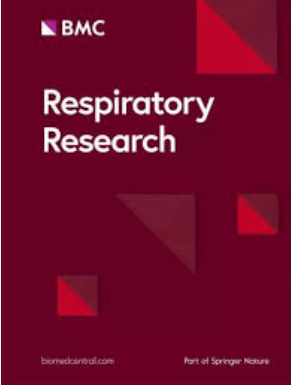Systemic IL-26 correlates with improved asthma control in children sensitized to dog allergen
IF 4.7
2区 医学
Q1 RESPIRATORY SYSTEM
引用次数: 0
Abstract
Interleukin (IL)-26 is produced by T helper type 17 (Type 17) cells and exerts immunomodulatory plus antimicrobial effects. Previous studies show that local IL-26 concentrations in the airways are higher in patients with uncontrolled than in those with controlled asthma, and that this intriguing cytokine bears biomarker potential. Here, we determined how systemic IL-26 relates to allergen sensitization, asthma severity, and to IL-17 A in children. Serum samples were obtained from children with (n = 60) and without (n = 17) sensitization to dog allergen, and IL-26 and IL-17 A protein concentrations were measured using ELISA. Self-reported history, including medication use and validated symptom-based questionnaire scores, was recorded. The serum concentrations of IL-26 were enhanced in allergen-sensitized subjects and correlated with those of IL-17 A in a positive manner. However, the IL-26 concentrations did not markedly differ between allergen-sensitized subjects with and without asthma, eczema, allergic rhinitis, or a history of food allergy. Notably, IL-26 concentrations correlated with increasing Asthma Control Test (ACT) scores in a positive manner and with inhaled corticosteroid in a negative manner, amongst sensitized subjects with asthma. Moreover, subjects with asthma requiring ≥ 1 course of oral corticosteroids in the preceding 12 months had decreased IL-26 concentrations. This study forwards evidence that systemic IL-26, just like IL-17 A, is involved in allergen sensitization among children. The association of systemic IL-26 with improved asthma control is compatible with the cellular sources being recruited into the airways in severe asthma, which supports that this kinocidin bears potential as a biomarker and therapeutic target.全身 IL-26 与对狗过敏原过敏的儿童哮喘控制率改善有关
白细胞介素(IL)-26 由 17 型 T 辅助细胞产生,具有免疫调节和抗菌作用。先前的研究表明,未受控制的哮喘患者气道局部 IL-26 浓度高于受控制的哮喘患者,这种有趣的细胞因子具有生物标记的潜力。在此,我们确定了儿童全身 IL-26 与过敏原致敏、哮喘严重程度以及 IL-17 A 的关系。我们从对狗过敏原过敏的儿童(n = 60)和未对狗过敏原过敏的儿童(n = 17)中采集了血清样本,并使用酶联免疫吸附法测定了 IL-26 和 IL-17 A 蛋白的浓度。同时还记录了自我报告的病史,包括用药情况和基于症状的有效问卷评分。过敏原致敏受试者血清中的IL-26浓度升高,并与IL-17 A的浓度呈正相关。然而,IL-26 的浓度在对过敏原过敏的受试者中有哮喘、湿疹、过敏性鼻炎或食物过敏史与无哮喘、湿疹、过敏性鼻炎或食物过敏史之间并无明显差异。值得注意的是,在过敏性哮喘受试者中,IL-26 浓度与哮喘控制测试(ACT)分数的增加呈正相关,与吸入皮质类固醇呈负相关。此外,在过去 12 个月中需要口服皮质类固醇≥1 个疗程的哮喘受试者的 IL-26 浓度有所下降。这项研究提供的证据表明,全身 IL-26 与 IL-17 A 一样,参与了儿童过敏原致敏的过程。全身性 IL-26 与哮喘控制的改善相关联,这与严重哮喘患者的气道细胞来源被招募到气道中是一致的,这支持了这种激肽作为生物标记物和治疗靶点的潜力。
本文章由计算机程序翻译,如有差异,请以英文原文为准。
求助全文
约1分钟内获得全文
求助全文
来源期刊

Respiratory Research
医学-呼吸系统
自引率
1.70%
发文量
314
期刊介绍:
Respiratory Research publishes high-quality clinical and basic research, review and commentary articles on all aspects of respiratory medicine and related diseases.
As the leading fully open access journal in the field, Respiratory Research provides an essential resource for pulmonologists, allergists, immunologists and other physicians, researchers, healthcare workers and medical students with worldwide dissemination of articles resulting in high visibility and generating international discussion.
Topics of specific interest include asthma, chronic obstructive pulmonary disease, cystic fibrosis, genetics, infectious diseases, interstitial lung diseases, lung development, lung tumors, occupational and environmental factors, pulmonary circulation, pulmonary pharmacology and therapeutics, respiratory immunology, respiratory physiology, and sleep-related respiratory problems.
 求助内容:
求助内容: 应助结果提醒方式:
应助结果提醒方式:


